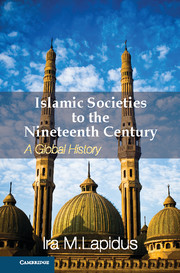Book contents
- Frontmatter
- Contents
- List of Illustrations
- List of Figures
- List of Maps
- List of Tables
- Preface
- Acknowledgments
- Acknowledgments to the first edition of A History of Islamic Societies
- Acknowledgments to the second edition of A History of Islamic Societies
- Publisher's Preface
- Introduction to Islamic Societies
- Part I The Beginnings of Islamic Civilizations
- Part II From Islamic Community to Islamic Society
- Part III The Global Expansion of Islam from the Seventh to the Nineteenth Centuries
- Chapter 25 Introduction: Islamic Institutions
- The Western Islamic Societies
- Islam in Asia
- Chapter 30 Introduction: Empires and Societies
- Chapter 31 The Turkish Migrations and the Ottoman Empire
- Chapter 32 The Postclassical Ottoman Empire: Decentralization, Commercialization, and Incorporation
- Chapter 33 The Arab Provinces Under Ottoman Rule
- Chapter 34 The Safavid Empire
- Chapter 35 The Indian Subcontinent: The Delhi Sultanates and the Mughal Empire
- Chapter 36 Islamic Empires Compared
- Chapter 37 Inner Asia From the Mongol Conquests to the Nineteenth Century
- Chapter 38 Islamic Societies in Southeast Asia
- Islam in Africa
- Conclusion
- Glossary
- Bibliography
- Annotated Bibliography from A History of Islamic Societies, 2nd Edition
- Index
Chapter 38 - Islamic Societies in Southeast Asia
Published online by Cambridge University Press: 05 February 2013
- Frontmatter
- Contents
- List of Illustrations
- List of Figures
- List of Maps
- List of Tables
- Preface
- Acknowledgments
- Acknowledgments to the first edition of A History of Islamic Societies
- Acknowledgments to the second edition of A History of Islamic Societies
- Publisher's Preface
- Introduction to Islamic Societies
- Part I The Beginnings of Islamic Civilizations
- Part II From Islamic Community to Islamic Society
- Part III The Global Expansion of Islam from the Seventh to the Nineteenth Centuries
- Chapter 25 Introduction: Islamic Institutions
- The Western Islamic Societies
- Islam in Asia
- Chapter 30 Introduction: Empires and Societies
- Chapter 31 The Turkish Migrations and the Ottoman Empire
- Chapter 32 The Postclassical Ottoman Empire: Decentralization, Commercialization, and Incorporation
- Chapter 33 The Arab Provinces Under Ottoman Rule
- Chapter 34 The Safavid Empire
- Chapter 35 The Indian Subcontinent: The Delhi Sultanates and the Mughal Empire
- Chapter 36 Islamic Empires Compared
- Chapter 37 Inner Asia From the Mongol Conquests to the Nineteenth Century
- Chapter 38 Islamic Societies in Southeast Asia
- Islam in Africa
- Conclusion
- Glossary
- Bibliography
- Annotated Bibliography from A History of Islamic Societies, 2nd Edition
- Index
Summary
Just as Islam spread from the Middle East to Inner Asia and from Afghanistan to India, in the late thirteenth, fourteenth, and fifteenth centuries it spread from various parts of India and Arabia to the Malay Peninsula and the Indonesian archipelago. Whereas the history of Islamic societies in other parts of Asia can be told in terms of empires and contiguous geographical areas, maritime Southeast Asia is a region of scattered peninsulas and islands. The sea was the connection among them. The region held a central position on the trade routes that connected China to the Indian Ocean, the Persian Gulf, and the Red Sea. The population of the region included not only local peoples but Chinese, Indians from Gujarat, and Arabs from Hadramawt. Hadramawtis were especially active as teachers, traders, judges, and officials and married and sired children with local women.
Whereas in other regions Islam was established by Arab or Turkish conquests, it was introduced into Southeast Asia by traveling merchants and Sufis, often coming from Arabia and western India. Whereas in the Middle East and India, Muslim regimes were founded by new political elites, in Southeast Asia existing regimes were consolidated by conversion to Islam. The continuity of elites gave strong expression to the pre-Islamic components of Southeast Asian–Islamic civilization. The royal culture of Java seems more local and less Muslim than the corresponding royal culture of the Mughal Empire was Indian. At the same time there were Muslim merchant communities typical of international Islam and also syncretisms of Islam and village cultures. Whereas Muslims remained a minority in India, in Indonesia and Malaya they became the overwhelming majority.
- Type
- Chapter
- Information
- Islamic Societies to the Nineteenth CenturyA Global History, pp. 561 - 580Publisher: Cambridge University PressPrint publication year: 2012



